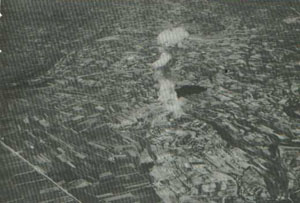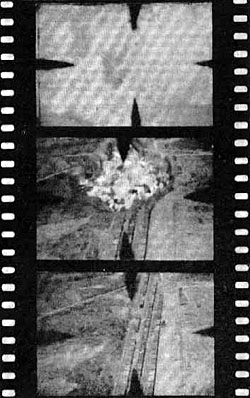1° Grupo De Aviação De Caça (1st Brazilian Fighter Group)Part Two: |  Gun camera footage of an ammo depot bombardment in the Po river valley. |
No one can really tell the story behind a real experience like the participants themselves. As to respect this philosophy, the second part of the 1° Grupo de Caça story must be told by its own members. Let us hear from these men.
1. Lt. Col. Nero Moura, 1° Grupo de Caça Commanding Officer:
"We had a distinctive form of operating, regarding 350th FG procedures, because we were a better trained bunch of guys compared to the North American outfit itself. We had more results, more action, and had the lion's share regarding those fellows.
That was because we arrived in theater with lots of flight experience, while the North Americans were just rookies (they never kept fighting to the end as the Brazilians did: after 35 missions, they were sent back home...). Our planes were used as an ultimate weapon: we had more bombing precision, we attacked ground targets better, and we saw things on land farther ahead, such as camouflaged ammo depots.
Just to mention an example, there was an allied armor column that penetrated deeply in the enemy lines, when it was suddenly detected by one of our pilots, Cap Horácio Machado, who promptly identified them as North Americans and immediately sent a message warning the Allied Command, which sent him a huge 'congratulations' for that. The Allied Command had no idea were the column was for more than ten hours, and the very first information, in the heat of combat, was given by the Brazilians, which kept that Allied column from being destroyed by their comrades!"
2. 2nd Lt. Alberto Martins Torres:
"On April 22, 1945, we had been sitting in our briefing room since 6 am waiting for the weather to improve when, at 1 pm, Col Nielsen dashed in and said: 'The Hun is on the run – take off!!'
The Germans were trying to escape to the northernmost region of Italy via the river Po valley, and my flight was the first to take off, being vectored by ground-based radar across the Apennines Mountains. After 40 minutes, 'Cooler' – the radar controller – guided us down the Po valley, and we broke out of the clouds at 2,000 ft and, going down to 1,000 ft, started hunting highway traffic.
Suddenly, we spotted a large mass of German armor and troops concentrated at a river margin, waiting for a pontoon bridge to be completed. We attacked the column's rear area so they could not retreat, and then strafed the many targets, including the bridge itself, until we ran out of ammunition. However, the enemy hit us hard in return and, thanks to the ruggedness of the P-47s, we had no losses but two badly shot up aircraft.
'Cooler' took us back to base through those clouds, while vectoring other flights to keep the pressure on that target. When we returned four hours later to resume attack, the enemy formation (we later heard that it was the remains of two whole divisions of the German army) had already been surrounded by North American armored units. This day was our best in theater."
|
|
3. 1st Lt. Luiz Felipe Perdigão:
"On the afternoon of April 24, 1945, I localized around 80 aligned boxcars at a railway junction west of Verona city... what would be their cargo? It could be anything: the Allied offensive was fully on, and the Wehrmacht was trying to save whatever it was able to, trying to concentrate its forces on the Alps passes, where it could resist a little bit longer.
Our orders were to 'intercept' all transportation, so I dove with my plane to strafe the boxcars, just to see the aftermath.... However, as soon as the gunnery began, everything just blew up, in a hell of fire, with flames up to 300 meters high, the resulting smoke climbing up to 2,000 meters high!! An immediate reaction (the explosion’s center is safer), a flashing thought (I died as my friend Santos), a red world, the melting hot of that big torch and, suddenly, the peacefulness of breaking through the other side, with my plane completely burned, smoked canopy, perforated wings, but still flying, going south, back to life, guarded by the other flight members, Paulo Costa, Tormin and Meira.
That was my most memorable mission, one to be never forgotten..."








